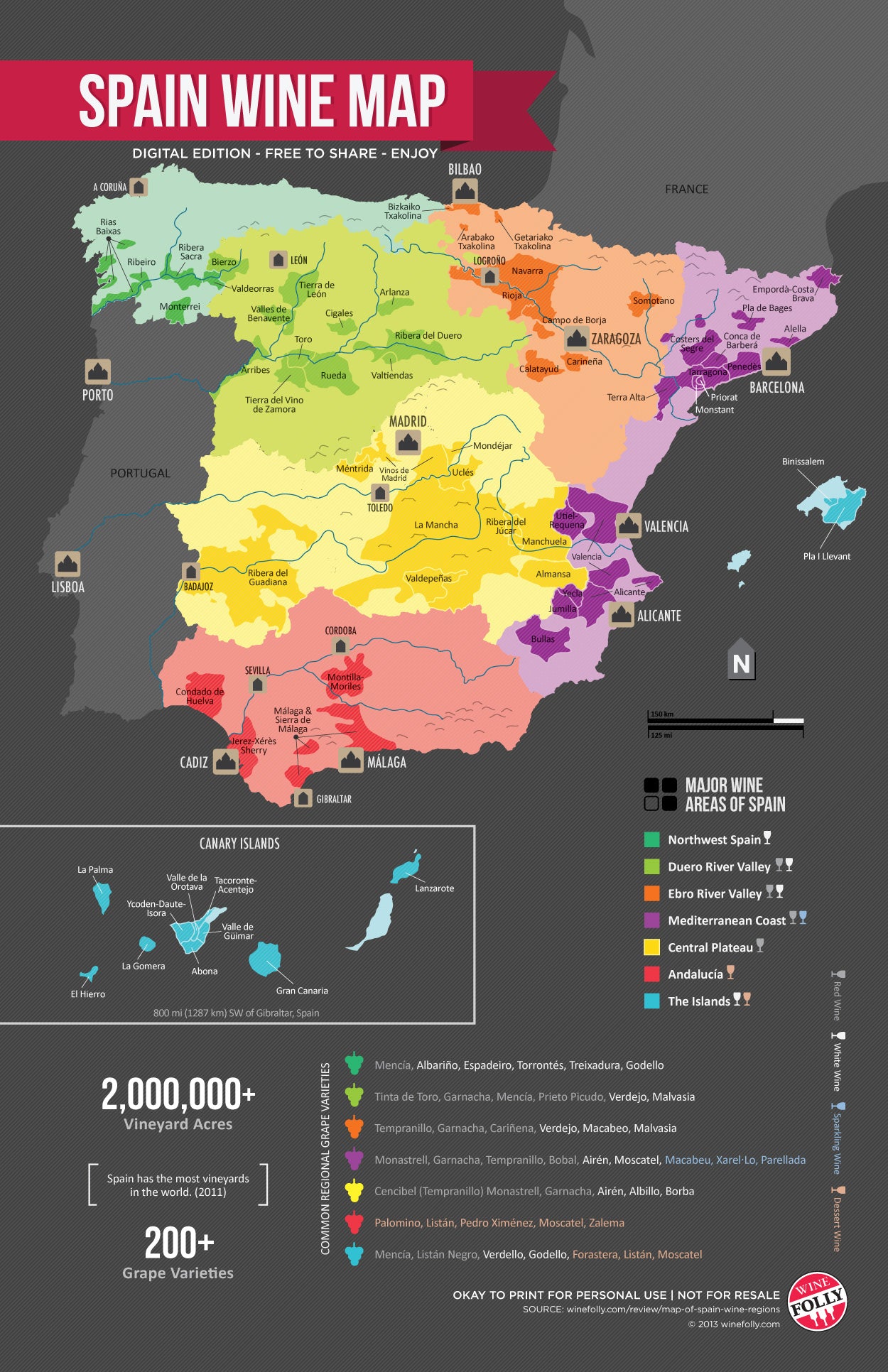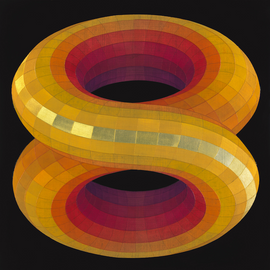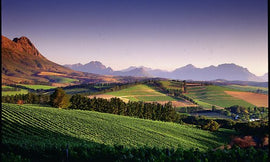All About Spain
San Francisco’s hottest nightclub is Spanish Wine (any SNL fans here?). This spot has it all: more vino per year by volume than all but two other countries (Italy and France); more land devoted to wine grape cultivation than any other nation - some 2.4 million acres divided into 60 officially designated wines regions (called DOs) and 138 different wine designations. Old vines, young vines, new vines that are actually old (because re-discovered), liminal vines of indeterminate lineage. Sherry - an utterly unique fortified wine genre that can hang with everything from oysters to ice cream; Cava, like Champagne but cheaper and with Iberian grapes; and Albarino, a world-class salt-frothed white, swimming with stone fruit and sunned by blue sky acidity. (Plus a Tapas +1 for all of them.)
Then there’s the reds: out of the aforementioned 60 DO’s, there are only two that receive the highest possible quality classification of DOCa, and both are primarily known for red wine. The first is Rioja, a chunk of north central Spain, bounded by mountains and extending for 90 miles on both sides of the Ebro river. Rioja - the word itself is a portmanteau of "Rio" (River) and "Oja" ( the name of a tributary of the Ebro) - is by far Spain’s best known wine region, synonymous with plush and fruity reds, made from the native Tempranillo and Garnacha varietals, aged in American oak. This style known as Traditional Rioja, is, ironically, a relatively recent innovation. In the 1860s, the twin scourges of phylloxera and mildew sent French vignerons scrambling south to make wine, and most ended up in nearby Rioja, bringing the méthode bordelaise to bear on local soils. At the time, barrel-grade European wood was difficult to come by, and expensive, so the Riojanos turned to America’s vast forests for cheap wood, which imparted to the wine the notes of vanilla, coconut and dill so closely associated with Rioja today. While none of this was a bad thing, the combination proved so popular that it necessitated large industrial scale production of blended grapes, obscuring the incredible breadth and complexity of climates and soils in the region. Fortunately, in the last 40 years, many native winemakers have chosen to focus on small, hyper-local viticulture and reviving older local traditions - not so much rejecting Traditional Rioja, as integrating it into an approach that more accurately records the terroir. Our selection from the region this quarter, comes from one such concern, Bodegas Ostatu, a family winery with deep roots in the region, operating out of Rioja Alavesa, the smallest of Rioja’s three sub-regions, known for higher elevation, relatively cooler weather, and softer, more finessed wines.
The other Spanish region with a DOCa classification is Priorat, a tiny, rural appellation in southwestern Catalonia; only two hours from Barcelona, but quite remote. The Estatuto del Vino (wine laws) issued by the Spanish Ministry of Agriculture in 1932 established the region as a place capable of producing world class wines and recognized it as a land to protect. However Priorat, deep in Republican territory, was devastated by the Civil War of the late 1930’s and it wasn’t until 1954 that it was given official DO status, and 2000 when it received the DOCa classification. In any event, Priorat’s steep hillside terrain and intense daytime heat make for difficult growing conditions and extremely low yields. The attraction, for the winemakers who do the hard work and the drinkers who pay the high prices, is the highly distinctive soil composition, known as llicorella. A rocky iron-rich blend of black slate and quartz which reflects
sunlight and conserves heat, llicorella imparts to the wines a rich depth of fruit and uniquely concentrated minerality obtainable nowhere else. Garnacha and Carinena (Grenache and Carignan) are the principal red varietals, but Cabernet Sauvignon, Merlot, and Syrah are allowed. The best red wines are dominated by Garnacha, or blended with Spanish and French varietals, and subject to varying methods of French barrique treatment. Salmos, the Priorat bottling included here, is a tribute to the monks of the Carthusian Monastery of Scala Dei, who arrived in Priorat in 1095 and introduced winegrowing there. It is a blend of Carinena, Garnacha and Syrah. Famille Serra, the producers, have themselves been making wine in Spain since the 19th century.
Outside of the two DOCa’s, there is much else to explore in Spanish Red, including Ribero Del Duero and Toro, two DO’s dedicated to lovely and distinctive variations on Tempranillo. But these days it’s possible the most interesting stuff is coming from Galicia, in the far northwest corner, bordering Portugal to the south, the Atlantic to the north and west and mountain ranges to the east. Home of the aforementioned Albarino, most notably in Rias Baixas, Spain's only exclusively white wine DO, Galicia is the wettest region in the country (the rain in Spain falls mainly…here) but with ample climatic diversity, the weather getting drier as you move inland, with maritime breezes giving way to continental gusts. The primary red grape is Mencia, Spain’s approximate Pinot Noir analogue, but intrepid vitiners all over the region are doing inspired work with obscure and forgotten varietals, unencumbered by strict DO rules. Case in Point: Teimosia (Galician for “perseverance”) a recent partnership between a trio of winemaking veterans in Rosal, a small village within 5 kilometeres of the Atlantic Ocean, technically in Rias Baixas, but unclassified. An extremely small production (less than 1,000 bottles total) it is a blend of the indigenous and new-to-us grapes Caíño Tinto, Castañal and Sousón, and singular: delicate and quite pretty but with intense flavor profiles of stonefruit and spice.
Salud!
PlumpJack Wine Team
|
Rioja Alavesa, Rioja, Spain |
About the Winery: Bodegas Ostatu is a family winery located in the heart of the Rioja Alavesa region in the town of Samaniego. The Saenz de Samaniego family has been in the area for many generations. The vineyards, which are protected by the Sierra Cantabria range, are composed of chalk and clay. The average age of the vines is 50 years old. Until recently all the wine was made in the carbonic maceration process with the intent being wines for early consumption. This philosophy recently changed when Hubert de Bouard de Laforest of Chateau Angelus saw the vineyard sites of the family and expressed an interest in collaborating on a special project. He realized that the age of the vines, combined with the unique orientation of the vineyards, could produce dramatically different wines that could compete on the world stage. By changing over from carbonic maceration to traditional fermentation and by reducing yields in the vineyards the wines made a drastic change in style. About the winemaking: After a manual harvest in small baskets, the grapes are destemmed and crushed with a brief pre-fermentation cold-soak and then fermented by native yeasts in stainless steel tanks without added sulfur. The fermentation lasts 14 days at a temperature of 24°C, with occasional gentle pump-overs. The wine is then racked into a large 500L, previously-used French oak foudre for malolactic fermentation, followed by seven months of aging in 1500L concrete eggs. Sulfur is not added during the process. 4000 bottle production. Tasting Notes: Attractive cherry red color, bright, medium depth. Its aromatic variety highlights fresh red fruits such as cherries and wild strawberries, flower petals. Pronounced savory flavors of green olives on the palate. Smooth entry and velvety mouthfeel throughout. |
|
Winemaker: Saenz de Samaniego Family |
|
|
$35 bottle/$378 case |
|
|
Suggested Food Pairing: Lamburgers Paella Chili con carne Tapenade with crostini |
|
|
DOQ Priorat, Spain |
About the Winery: Familia Torres founded its first winery in Vilafranca del Penedès in 1870, 150 years ago, but its roots in the winegrowing traditions of Spain date back to the 16th century. Five generations have carried the family business forward, passing on their passion for wine culture from parents to children – a passion steeped in respect for land and tradition, and a firm belief in innovation. Today the family focuses on wines from unique vineyards and historical estates, as well as the recovery of ancestral varieties. Familia Torres has a historical connection to Penedès, Conca de Barberà, Priorat, and Costers del Segre, but now its presence extends to vineyards and wineries in preeminent Spanish wine regions – Rioja, Ribera del Duero, Rueda, and Rías Baixas. About the Winemaking: In 2017, temperatures were within normal range throughout the growth season, but showed some variation across the year: the first half was warmer—June was particularly hot—but the ripening period was unusually cool due to lower temperatures in September. In terms of total precipitation, the growth season saw little rainfall, and it is worth noting that the ripening period was especially dry. Shallow soils developed over Carboniferous (Paleozoic) slates that drain swiftly and have a low water holding capacity. It is precisely these soils, located on steep slopes, that give Priorat wines their typicity. Fermentation takes place in stainless steel under controlled temperature for 8-9 days. 12-14 days maceration and 14 months in French oak (20% new.) Tasting Notes: Brilliant ruby red in color with garnet highlights. Astounding rose and black cherry aroma with aromatic herbs such as thyme coming through. Lively and light-bodied on the palate, full of personality, well structured with pleasant tannins and a streak of acidity that promises a long future. |
|
Managing Director: Miguel Torres Maczassek |
|
|
$40 bottle/ $432 case |
|
|
Suggested Food Pairing: Petit Basque Cheese Chorizo Pasta with Spinach Steak with Pepper sauce BBQ Pork Ribs |
|
|
Tomiño, Pontevedra, Galicia |
About the winery: Teimosía (perseverance in Galician) was born from a collaboration between Martín Crusat (Adega do Vimbio), Dominique Roujou de Boubée (Terroir en Botella), and Joaquín "Quín" Álvarez, historical vinegrower of the Rosal for 50 years. In this small, handcrafted project, their goal and inspiration is to reveal the personality of Rosal reds. The microclimate of this area gives their wines a distinct identity from those produced in the Salnés valley of Rías Baixas and although the vineyard plots are in the Rías Baixas region, the wines are bottled without appellation. About the winemaking: A blend of Caíño Tinto, Castañal and Sousón. Harvested by hand in late September. Spontaneous fermentation, 10 months in new French oak barrels of 228L (31%) and stainless steel tank (69%): Artisanal process, fermentation with native yeasts (pie de Cuba). Tasting Notes: Although not pitch black, it's still quite dark and opaque. It has a very intense nose like concentrated violets with an earthy, oaky touch. Stewed plum and raisin notes with spicy, herbaceous fruit tones are pronounced on the palate, with bold tannin structure and moderate acidity. Very complex with an extremely long finish. |
|
Winemaker: Martín Crusat, Dominique Roujou de Boubée & Joaquín "Quín" Álvarez |
|
|
$ 51 bottle/ $550.8 case |
|
|
Suggested Food Pairing: Lamb stew with root vegetables Pork with cumin, lemon and cilantro Roasted Guinea fowl Manchego Cheese
|
|





